并列连词、并列句复习过程
- 格式:doc
- 大小:29.00 KB
- 文档页数:5
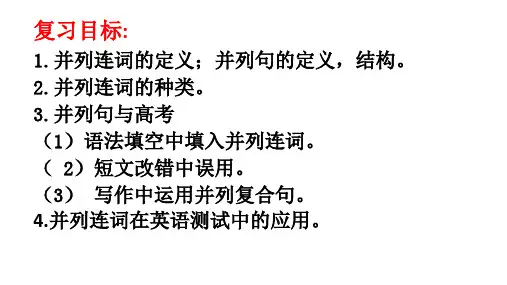
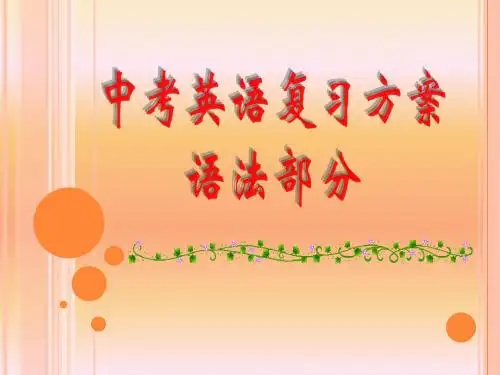
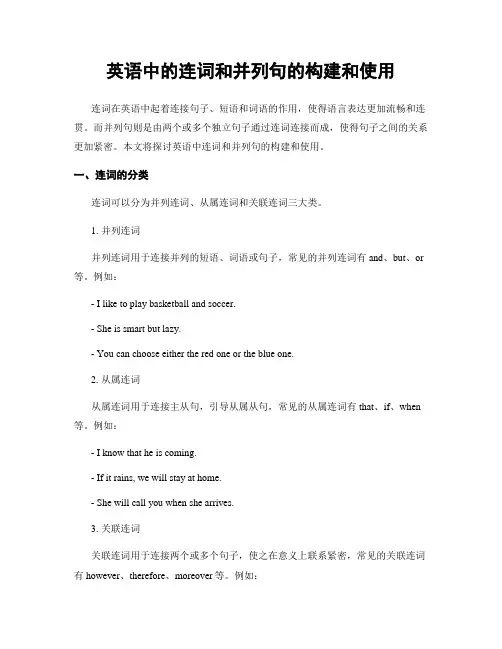
英语中的连词和并列句的构建和使用连词在英语中起着连接句子、短语和词语的作用,使得语言表达更加流畅和连贯。
而并列句则是由两个或多个独立句子通过连词连接而成,使得句子之间的关系更加紧密。
本文将探讨英语中连词和并列句的构建和使用。
一、连词的分类连词可以分为并列连词、从属连词和关联连词三大类。
1. 并列连词并列连词用于连接并列的短语、词语或句子,常见的并列连词有and、but、or 等。
例如:- I like to play basketball and soccer.- She is smart but lazy.- You can choose either the red one or the blue one.2. 从属连词从属连词用于连接主从句,引导从属从句,常见的从属连词有that、if、when 等。
例如:- I know that he is coming.- If it rains, we will stay at home.- She will call you when she arrives.3. 关联连词关联连词用于连接两个或多个句子,使之在意义上联系紧密,常见的关联连词有however、therefore、moreover等。
例如:- He is a good student; however, he is always late for class.- She studied hard; therefore, she passed the exam.- The weather is nice; moreover, the scenery is beautiful.二、并列句的构建和使用并列句是由两个或多个独立句子通过连词连接而成的,使得句子之间的关系更加紧密。
并列句可以用于表达对比、选择、因果关系等。
以下是一些常见的并列句结构和使用方法。
1. 对比关系使用连词but、while、whereas等来表达对比关系。
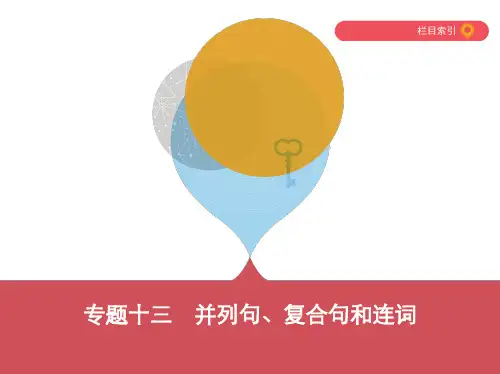
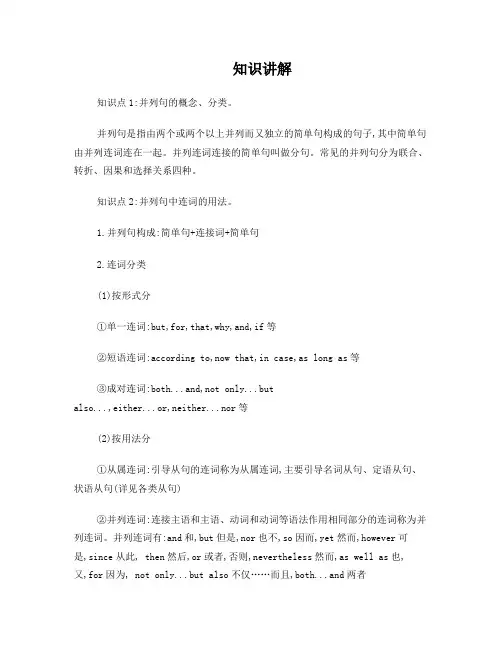
知识讲解知识点1:并列句的概念、分类。
并列句是指由两个或两个以上并列而又独立的简单句构成的句子,其中简单句由并列连词连在一起。
并列连词连接的简单句叫做分句。
常见的并列句分为联合、转折、因果和选择关系四种。
知识点2:并列句中连词的用法。
1.并列句构成:简单句+连接词+简单句2.连词分类(1)按形式分①单一连词:but,for,that,why,and,if等②短语连词:according to,now that,in case,as long as等③成对连词:both...and,not only...butalso...,either...or,neither...nor等(2)按用法分①从属连词:引导从句的连词称为从属连词,主要引导名词从句、定语从句、状语从句(详见各类从句)②并列连词:连接主语和主语、动词和动词等语法作用相同部分的连词称为并列连词。
并列连词有:and和,but但是,nor也不,so因而,yet然而,however可是,since从此, then然后,or或者,否则,nevertheless然而,as well as也,又,for因为, not only...but also不仅……而且,both...and两者都,neither...nor既不……也不……,either...or或者……或者注意:并列连词要注意主谓一致问题(详见主谓一致)3.连词种类及用法(1)积累连词①and(和;同;与;又;并且)Eg:Mary and Lily are both interested in collecting stamps.②both...and(既...又...)Eg:Both you and I have changed a lot in the past twenty years.③not only...but also(不仅...而且...)Eg:Not only you but also I am to blame.(就近)④as well as(和;同;也;除...之外)Eg:You as well as I are supposed to respect the old. (主谓一致)注意:名词A + as well as + 名词B,作主语,强调A not only + 名词A + but also + 名词B,作主语,强调B⑤never...but (除了……不会) Eg:It never rains but it pours.(2)转折连词①but(但是;可是;而;却)Eg:The situation looked desperate,but they didn’t give up hope.②while(而;但是;可是;却)Eg:He is fat while his sister is thin.③however,nevertheless,y et,still(但是;然而;尽管如此)Eg:She always tells lies,nevertheless,I still trust her.④when(正当那时;突然;=and just at that time)Eg:I was just about to leave when the telephone rang.(3)选择连词or(否则,要不然;肯:或者,还是;否:也不;)Eg:Do you want to leave now or would you rather set off later?②otherwise/or else/or(否则)Eg:You will have to go now,or/orelse/otherwise you will miss the bus.③neither...nor(既不...也不...)Eg:The equipment is neither accurate nor safe.④either...or(或是...或是...;不是...就是...)Eg:Either she leaves the house,or I will call the policeman. A or B or C 注意:多个对象选择either A or B or C Neither A nor B nor C⑤not...but(不是...而是...)Eg:The teacher didn’t scold him,but comforted him.(4)因果连词①so(原因+so+结果,意为因此,所以)Eg:I heard a noise,so I got out of bed and turned on the light. 注意:不能与because出现在同一句子中,因为because是从属连词,so是并列连词②for(结果+for+原因,意义上与从属连词because/since/as相同,但只能接简单句)Eg: The day must break now,for the birds are singing now. 注意:for引导的句子只能置于句末,之前必须有逗号for分句不能用来回答why问句(5)rather than(而不是;与其...宁愿...)Eg:Rather than ride on a crowded bus,he always prefers to ride bicycle.4.并列句的省略:若后面分句有词和前面分句的词重复,为避免重复,可省Eg:I work in a factory and my sister (works) on a farm. She could have applied for that job,but she didn't (applied for that job).1.【考查点】联合关系的并列句中,常见的连词有and, not o nly…but (also), neither…nor…等。
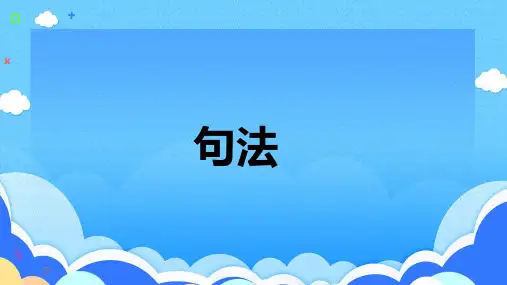
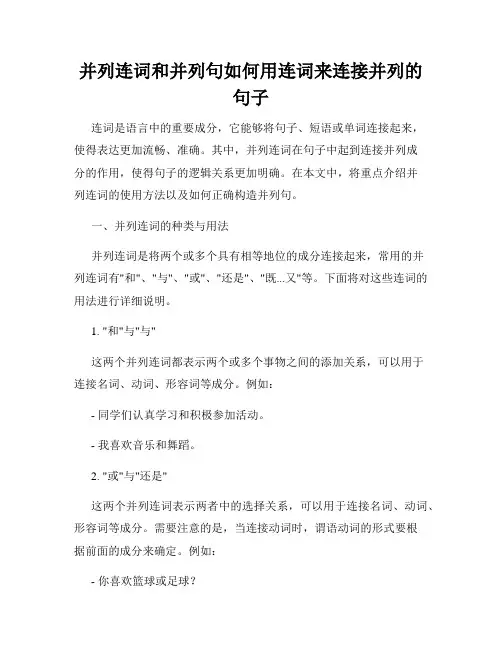
并列连词和并列句如何用连词来连接并列的句子连词是语言中的重要成分,它能够将句子、短语或单词连接起来,使得表达更加流畅、准确。
其中,并列连词在句子中起到连接并列成分的作用,使得句子的逻辑关系更加明确。
在本文中,将重点介绍并列连词的使用方法以及如何正确构造并列句。
一、并列连词的种类与用法并列连词是将两个或多个具有相等地位的成分连接起来,常用的并列连词有"和"、"与"、"或"、"还是"、"既...又"等。
下面将对这些连词的用法进行详细说明。
1. "和"与"与"这两个并列连词都表示两个或多个事物之间的添加关系,可以用于连接名词、动词、形容词等成分。
例如:- 同学们认真学习和积极参加活动。
- 我喜欢音乐和舞蹈。
2. "或"与"还是"这两个并列连词表示两者中的选择关系,可以用于连接名词、动词、形容词等成分。
需要注意的是,当连接动词时,谓语动词的形式要根据前面的成分来确定。
例如:- 你喜欢篮球或足球?- 你是喝咖啡还是喝茶?3. "既...又""既...又"表示两个并列的事物或情况同时存在。
例如:- 这部电影既有悬疑又有喜剧元素。
二、并列句的构造与运用并列句由两个或多个并列的句子构成,每个句子都有自己的主语和谓语。
在构造并列句时,需要注意以下几点:1. 主谓一致在并列句中,主句和从句的主语和谓语要保持一致,这样才能使句子结构完整、语法正确。
例如:- 我喜欢读书,他喜欢看电影。
2. 注意逗号的使用在并列句中,如果并列的句子之间有停顿或明显的语调变化,需要使用逗号来分隔句子。
例如:- 她喜欢跳舞,他喜欢画画。
3. 并列连词的运用在连接并列句时,需要使用适当的并列连词。
在选择并列连词时,要根据句子的意思来确定使用哪种连词。
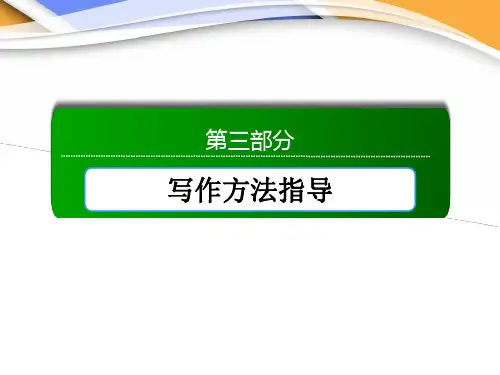
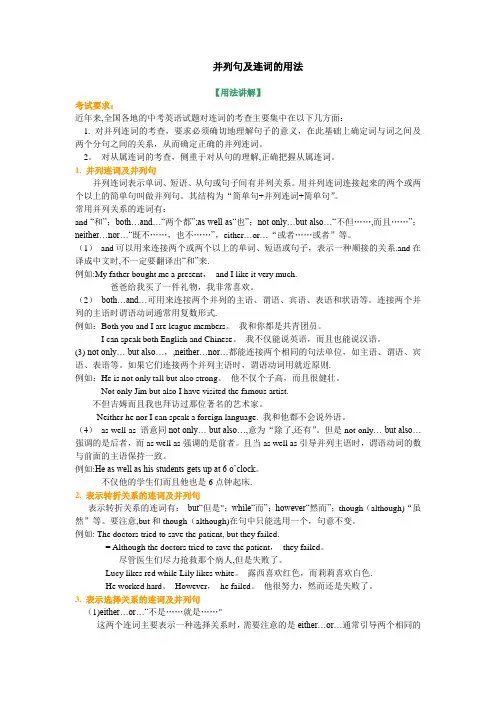
并列句及连词的用法【用法讲解】考试要求:近年来,全国各地的中考英语试题对连词的考查主要集中在以下几方面:1. 对并列连词的考查,要求必须确切地理解句子的意义,在此基础上确定词与词之间及两个分句之间的关系,从而确定正确的并列连词。
2。
对从属连词的考查,侧重于对从句的理解,正确把握从属连词。
1. 并列连词及并列句并列连词表示单词、短语、从句或句子间有并列关系。
用并列连词连接起来的两个或两个以上的简单句叫做并列句。
其结构为“简单句+并列连词+简单句”。
常用并列关系的连词有:and “和”;both…and…“两个都”;as well as“也”;not only…but also…“不但……,而且……”;neither…nor…“既不……,也不……”,either…or…“或者……或者”等。
(1)and可以用来连接两个或两个以上的单词、短语或句子,表示一种顺接的关系.and在译成中文时,不一定要翻译出“和”来.例如:My father bought me a present,and I like it very much.爸爸给我买了一件礼物,我非常喜欢。
(2)both…and…可用来连接两个并列的主语、谓语、宾语、表语和状语等。
连接两个并列的主语时谓语动词通常用复数形式.例如:Both you and I are league members。
我和你都是共青团员。
I can speak both English and Chinese。
我不仅能说英语,而且也能说汉语。
(3) not only… but also…,,neither…nor…都能连接两个相同的句法单位,如主语、谓语、宾语、表语等。
如果它们连接两个并列主语时,谓语动词用就近原则.例如:He is not only tall but also strong。
他不仅个子高,而且很健壮。
Not only Jim but also I have visited the famous artist.不但吉姆而且我也拜访过那位著名的艺术家。
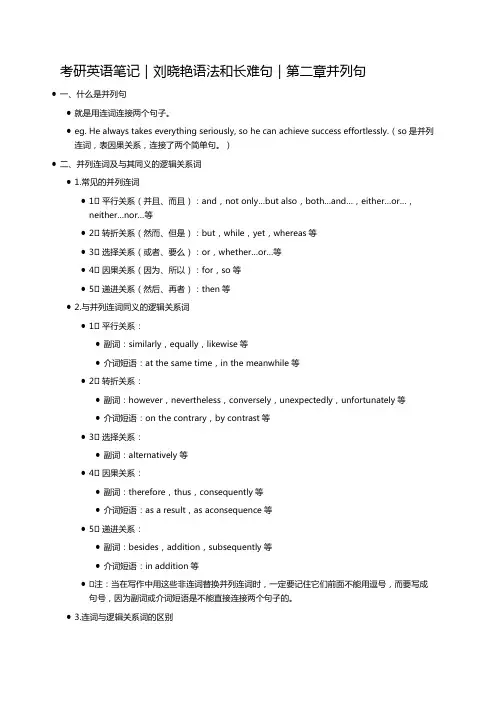
考研英语笔记|刘晓艳语法和长难句|第二章并列句●一、什么是并列句●就是用连词连接两个句子。
●eg. He always takes everything seriously, so he can achieve success effortlessly.(so是并列连词,表因果关系,连接了两个简单句。
)●二、并列连词及与其同义的逻辑关系词●1.常见的并列连词●1⃣️ 平行关系(并且、而且):and,not only…but also,both…and…,either…or…,neither…nor…等●2⃣️ 转折关系(然而、但是):but,while,yet,whereas等●3⃣️ 选择关系(或者、要么):or,whether…or…等●4⃣️ 因果关系(因为、所以):for,so等●5⃣️ 递进关系(然后、再者):then等●2.与并列连词同义的逻辑关系词●1⃣️ 平行关系:●副词:similarly,equally,likewise等●介词短语:at the same time,in the meanwhile等●2⃣️ 转折关系:●副词:however,nevertheless,conversely,unexpectedly,unfortunately等●介词短语:on the contrary,by contrast等●3⃣️ 选择关系:●副词:alternatively等●4⃣️ 因果关系:●副词:therefore,thus,consequently等●介词短语:as a result,as aconsequence等●5⃣️ 递进关系:●副词:besides,addition,subsequently等●介词短语:in addition等●⚠️注:当在写作中用这些非连词替换并列连词时,一定要记住它们前面不能用逗号,而要写成句号,因为副词或介词短语是不能直接连接两个句子的。
●3.连词与逻辑关系词的区别●1⃣️ 使用连词时,可以加逗号,也可以不加●I love you,but you love my money.或I love you but you love my money.●2⃣️ 使用副词或介词时,必须把逗号变句号,或者是在副词或介词短语前加连词and。
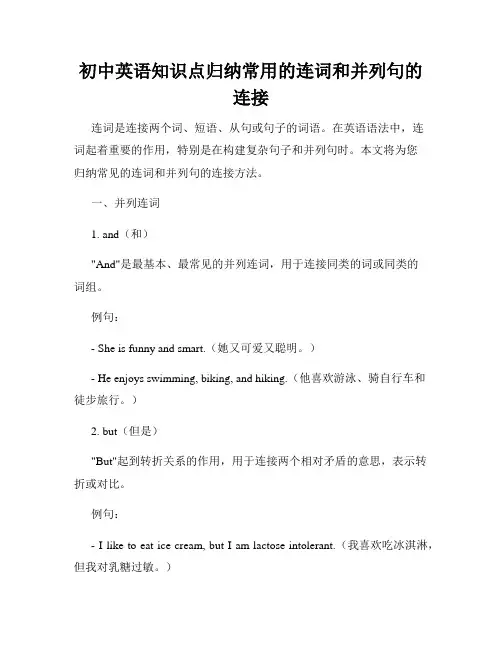
初中英语知识点归纳常用的连词和并列句的连接连词是连接两个词、短语、从句或句子的词语。
在英语语法中,连词起着重要的作用,特别是在构建复杂句子和并列句时。
本文将为您归纳常见的连词和并列句的连接方法。
一、并列连词1. and(和)"And"是最基本、最常见的并列连词,用于连接同类的词或同类的词组。
例句:- She is funny and smart.(她又可爱又聪明。
)- He enjoys swimming, biking, and hiking.(他喜欢游泳、骑自行车和徒步旅行。
)2. but(但是)"But"起到转折关系的作用,用于连接两个相对矛盾的意思,表示转折或对比。
例句:- I like to eat ice cream, but I am lactose intolerant.(我喜欢吃冰淇淋,但我对乳糖过敏。
)- She is tired, but she still wants to finish her homework.(她很累,但她还是想完成她的作业。
)3. or(或者)"Or"用于表示选择关系,连接两个或多个可替代的选项。
例句:- Do you want a coffee or a tea?(你想要喝咖啡还是茶?)- You can choose to study English or French.(你可以选择学英语或法语。
)4. so(所以)"So"用于表示因果关系,连接原因和结果。
例句:- It's raining, so I will take an umbrella.(下雨了,所以我会带一把伞。
)- He studied hard for the test, so he got a good grade.(他为了这个考试努力学习,所以他得了一个好成绩。
)二、从属连词1. because(因为)"Because"引导原因状语从句,用来解释原因。
考点25 并列连词和并列句高考频度:★★★★★【命题解读】连词分为并列连词和从属连词两大类。
并列连词是连接主语与主语、谓语与谓语、句子与句子、分词与分词的词,它要求前后两部分有相同的形式和语法作用。
【命题预测】预计2021年高考对连词的考查主要集中在简单句、并列句和各种复合句的掌握上,尤其是对连词的选择与使用上,如:and, but, or, while等等。
【复习建议】1.掌握并列连词的基本用法;2.掌握并列连词的固定句型。
考向一并列句一、并列连词1.表示并列关系的连词:and: 可用来连接两个或两个以上的单词/短语或句子,表示一种顺接的关系。
We are singing and they are dancing.or:用于否定句中连接并列成分,表示"和,与";用于"祈使句+or+陈述句"中,意为"否则,要不然"。
The baby is too young. He can’t speak or walk.both…and:"两个都……",连接两个并列主语时谓语动词用复数。
Both Li Ping and Mary are going to the Great Wall tomorrow.either…or…:"要么……要么",连接的并列成分可在句中作主语、表语、宾语等。
连接并列成分作主语时,谓语动词通常与or后的部分保持一致。
Either she or I am right.neither…nor: "既不……也不……",连接的并列成分可在句中作主语、表语、宾语等。
连接并列成分作主语时,谓语动词通常与nor后的部分保持一致。
Neither he nor I am right.not only…but also: "不仅……而且……",强调后者;引导并列主语时,谓语动词与后面的主语保持一致。
Not only the students but also the teacher gives the money to our school.2. 表示转折关系的并列连词but "但是",所连接的成分意思相反或相对。
2021年高考英语语法复习:并列句和状语从句一、并列句考点一常见并列句的类型及并列连词Both Peter and Tom are from South Africa.彼得和汤姆都来自南非。
First,my English is very good and I’m open-minded and warm-hearted,so I’m getting along well with everyone.首先,我的英语很好,而且我性格外向、很热心,因此我和每个人都相处得很好。
He tried hard to catch up with his classmates,but he failed.他尽力赶上同学们,但是失败了。
The children can go with us,or they can stay in.孩子们可以跟我们去,也可以待在家里。
He must have been caught in the rain,for he is wet all over.他肯定被雨淋了,因为他浑身都湿了。
考点二并列连词构成的常用句型1.and构成的句型(1)祈使句+and+陈述句(祈使句相当于一个条件状语从句,and后面的句子相当于一个表示结果的主句)。
Go on like this and I am sure you will be successful in time.继续这样努力,我确信你最终会成功的。
(2)名词(词组)+and+陈述句(名词相当于一个条件状语从句,其中常含有more,another等词)。
Another try,and you’ll make a success.再试一次,你就会取得成功。
2.or (else)构成的句型(1)祈使句+or (else)+陈述句。
Seize the chance,or (else) you’ll regret.抓住这次机会,否则你会后悔的。
(2)名词(词组)+or (else)+陈述句。
并列句
并列句是由两个或两个以上的简单句连接而成。
并列句中的各简单句意义同等重要,相互之间不是从属关系,而是平行并列的关系。
两个简单句常用并列连
注意:and常用于肯定句中,表肯定列举;or常表示选择和否定的列举,常用于选择疑问句或否定句中。
【边学边做】用and,but,or或so填空。
1. Study hard, ______ you will fail the exam.
2. Her father is a doctor ______ her mother is a teacher.
3. He would like to go to the cinema, ______ he can’t.
4. Remember to return the book to the library in time, ______ you will be fined(罚款).
5. Sally really want s a cat, ______ her father won’t let her have one.
6. Bill is ill at home, ______ he can’t come to the party now.
7. Try your best, ______ you are sure to win the match.
8. Nancy lost her favourite pen, ______ she felt very sad.
并列连词大观园
连接具有并列关系的词、短语或句子的连词叫做并列连词。
根据其意义,并列连词又分为表示并列、转折、选择和因果等四种关系的连词。
【边学边做】
()1. Which one is heavier, the wooden ball ______ the iron ball?
A. or
B. and
C. but
D. so
()2. Hold on to your dream, _______ one day they may just come true.
A. and
B. but
C. so
D. or
()3. Work hard, ______ you’ll pass the English exam this time.
A. or
B. but
C. because
D. and
()4. --- Was the boy saved?
--- No. The doctors tried their best, _______ they failed.
A. and
B. so
C. but
()5. We’re going to the bookstore. You can go with us ______ you can meet us there.
A. and
B. but
C. or
D. then
6. 我和他昨天都去了龙湖公园。
______ he ______ I went to Longhu Park yesterday.
7. 我不想骑自行车去那儿,他也不想。
______ I ______ he wants to go there by bike.
8. 你要么和我一起去,要么待在家里。
You will ______ go with me ______ stay at home.
9. 我不仅喜欢数学,而且喜欢物理。
I like ______ ______ math ______ ______ physics.
10. 他已经来这里三年了。
但是,他还几乎没有朋友。
He has been here for three years. ________, he has few friends.
并列句的家庭会议
并列句是由并列连词把两个或两个以上的简单句连接起来的句子,其结构为“简单句+并列连词+ 简单句”。
常见的并列连词有and, but, so 和or。
这不, 弟兄四个人聚在一起,煞有介事地开起会来了。
那咱们就来听听吧!
and自述———
我的意思是“和”,有我的并列句表示联合关系。
如:彼得踢足球,并踢得很好。
Peter plays football, and he is good at it.
but自述———
我的意思是“但是”,和我在一起的并列句当然是表示转折的关系了。
在使用时,千万要注意我有一个冤家,它是though 或although(虽然,尽管),有它没我,有我没它!
如:虽然天下着雨,但是我还是去上学了。
It rained heavily, but I still went to school.
so自述———
我的意思是“所以”,有我的并列句表示因果关系。
我呢,也有一个不能出现的死对头,because (因为)。
在使用时,你可要小心了。
如:因为没有车了,所以我不得不走着回家。
I had to walk home because there was no bus.
There was no bus, so I had to walk home.
or自述———
我有两个意思,“或者”或“否则”,和我在一起的并列句表示选择关系。
如:你可以待在家里,或者跟我们去钓鱼。
You can stay at home, or go fishing with us.
好好学习吧,否则你就落后于其他人了。
Work hard, or you’ll fall behind others.
怎么样,听完了四兄弟的自述,对并列句掌握的怎么样了呢?来“并列句操练场”大显身手吧!
并列句操练场
1. Open the door_________ let the cool air in.
2. There are few new words in the article, _________we couldn’t understand it.
3. I like beef, __________my father doesn’t like it.
4. We finished the homework quickly _______ it was very easy.
5. Be more careful, _______ you’ll have an accident.
6. It’s raining very hard, ________ we’d better stay here.
7. Claire wanted to buy a car, _______ he didn’t have enough money.
8. He’s always very careful, ______ he never makes any mistakes.
9. Take a raincoat with you, ________ you’ll get wet.
10. He kept on working outside, _________ it was colder and colder.
Keys: 1. and 2. but 3. but 4. because 5. or
6. so
7. but
8. so
9. or 10. though。